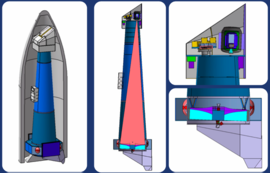The X-ray Integral Field Unit onboard the Athena space X-ray observatory Didier Barret
le 09 déc 2016 de11h00à 13h002016/12/09 2016/12/09

The Advanced Telescope for High-Energy Astrophysics will be launched in 2028 by the newly developed Ariane 6. It is the second large mission of the European Space Agency science program, and the successor of the XMM-Newton and Chandra X-ray space observatories. Athena will observe with unprecedented capabilities the Universe in X-rays, revealing how the large scale structures of hot gas formed and evolved along dark matter potential wells and how black holes were born, grew up and shape the Universe. Athena will carry a large collecting area grazing incidence X-ray telescope of 12 meter focal length, with the beam converging onto either a wide field imager (WFI) or an X-ray Integral Field Unit (X-IFU), a revolutionary 3D high resolution X-ray spectrometer. The X-IFU is being developed by an international scientific consortium led by IRAP, with the French Space Agency (CNES) leading the project management and the instrument development and procurement. In this talk, I will recall the historical steps that led to the selection of Athena. I will briefly review its core scientific objectives, describe its science payload with emphasis on the X-IFU, which is based on a large format array of superconducting Transition Edge Sensors cooled down to ~50 milli-kelvins. I will conclude by listing the major milestones in the project development to be overcome for Athena to be launched towards the end of the next decade, and highlight the many opportunities offered to young students to join this extraordinary challenge.




